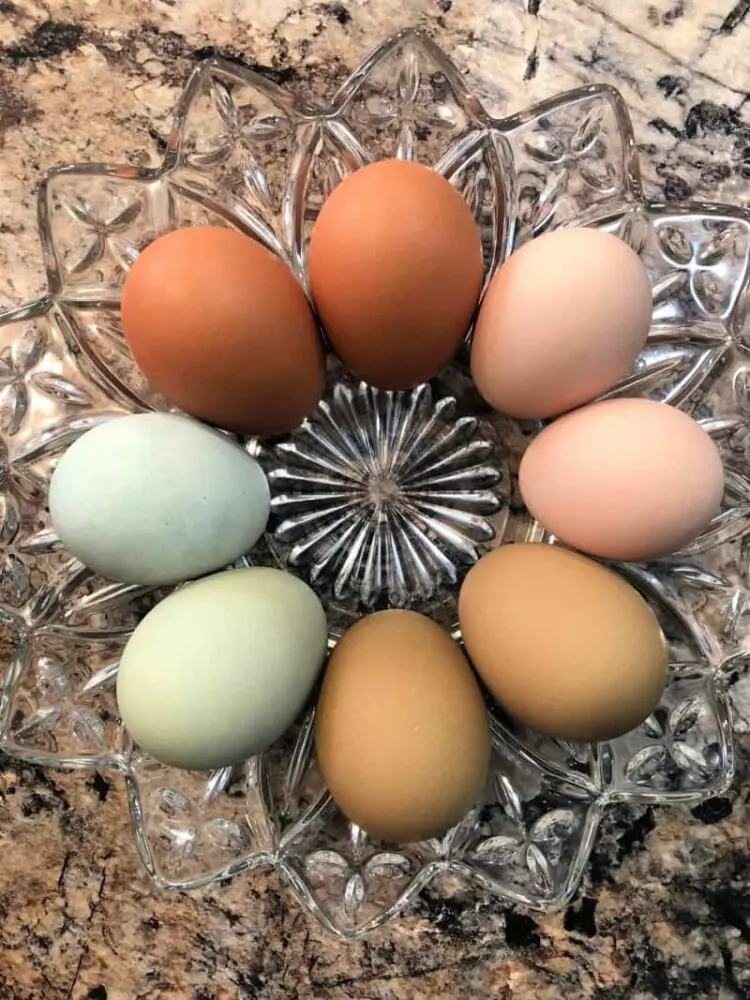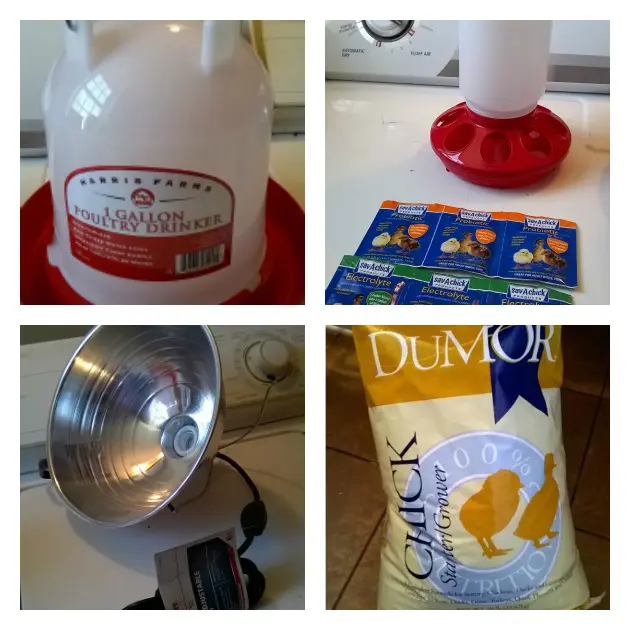If you have a yard, you can have 6 chickens that will provide your family as much as 1/2 dozen eggs a day for your family. This gives you enough for your family and enough to share a few with neighbors and friends. Beginners, raising chickens in your backyard is totally doable and you will love raising chickens for eggs that taste amazing. If you are like us, you shudder to think of the unhealthy conditions many commercial chicken operations raise their chickens under to bring you a far less egg quality. My grandparents on both sides of my family kept laying chickens. It was an enriching part of our childhood whenever we visited grandmother, to collect the eggs every morning. It was a wholesome tradition and created many fond memories. Here’s how to raise chickens yourself!
Benefits of Raising Chickens For Eggs:
- Lower Your food bill
- Become less dependent on grocery-bought food, more self-sufficient
- Fresh, healthy eggs
- Natural, organic, and humane (cruelty-free)
- Superior taste and quality
- Free from growth hormones
- Great experience for children
Raising chicks comes with a host of benefits that make the effort and time well worth it. One of the most rewarding aspects is the opportunity to witness firsthand the growth and development of these young birds. Additionally, raising chicks can provide a source of fresh eggs for you and your family. There is nothing quite like gathering eggs from your own backyard and knowing exactly where your food comes from. Not only do home-grown eggs taste better, but they are also higher in nutrients compared to store-bought alternatives, making them a healthier choice for you and your loved ones.
Growing up the backyard eggs were so fresh and tasty, we certainly got spoiled by the vastly different quality and taste. The yolks were firm and deep orange (rather than the limp, light yellow you get at the store). The taste was so good Grandma would make egg sandwiches for lunch. I remember my Grandma making lemon meringue pie which uses egg whites to whip up the fluffy meringue topping. I wouldn’t even want to do meringue with runny whites from store bought eggs. My point being that with store bought eggs, the enjoyment level of eating them just does not compare with raising chickens for eggs.
Plus, imagine the fun for the children and grandchildren in your family on Easter! This is the good-old fashioned Easter every child dreams of. Furthermore, raising chicks can be a great educational experience for both children and adults alike. It offers an opportunity to learn about the natural behaviors of chickens, their nutritional needs, and how to care for them properly. This hands-on approach to learning can instill a sense of responsibility and empathy towards animals, fostering a deeper connection to the natural world.
From Chick to Hen: A Beginner’s Guide to Raising Chickens
Are you considering adding chickens to your backyard flock? Whether you’re drawn to the idea of fresh eggs each morning or just enjoy the company of these feathered friends, taking care of chicks and raising them into hens can be a rewarding experience. In this beginner’s guide, we’ll walk you through the essential steps and tips for successfully raising chicks and transitioning them into healthy, egg-laying hens. From setting up a cozy brooder to providing proper care and transitioning them to the coop, we’ll cover everything you need to know to ensure your flock thrives. So, if you’re ready to embark on this feathered journey, let’s dive in and learn how to go from chick to hen.
How To Grow Six Egg Laying Chicks To Feed Your Family
The baby chicks themselves we bought for about $3 each little chick. That is not too bad considering your dozen chicks will lay you about 4000 eggs in their 2-3 productive years of laying as backyard chickens!
I recommend that beginners start with raising six backyard chickens for a few practical reasons:
- Egg Production: A typical laying hen produces around 4–6 eggs per week. Six chickens can provide a steady supply of eggs for a family without overproducing.
- Balanced Flock: Chickens are social animals and do best in small groups. Six is a good number to maintain flock dynamics, where they establish a clear pecking order without overcrowding.
- Space Management: For small to medium-sized backyards, six chickens can comfortably live in a coop and run without needing an excessive amount of space. It provides a balance between sustainability and maintenance.
- Variety and Health: A flock of six chickens can allow for a mix of breeds, offering diversity in egg color, temperament, and hardiness. It also means if one chicken falls ill or stops laying, the flock can still function without significant disruption.
- Fewer Resource Strains: Caring for six chickens is generally manageable for someone with a small garden and allows for easier control over feed, coop cleaning, and health monitoring.
- Legal Limits: In some areas, local ordinances or HOA rules might limit the number of chickens you can have, and six is often the upper limit.
Chick Brooder
Setting up your chick brooder is the first step in providing a warm and secure space for your new feathered friends. Choose a brooder that is spacious enough to accommodate your chicks as they grow, with ample room for them to move around freely. Line the bottom of the brooder with clean, absorbent bedding such as pine shavings or straw to keep them dry and comfortable. Make sure to place a heat lamp above one side of the brooder to maintain a temperature of around 95 degrees Fahrenheit for the first week, gradually decreasing it by five degrees each week until they are fully feathered.
Initially, the largest raising chickens for eggs expense would be your baby chick nursery (brooder). For several weeks when they are small they require a warm “nest.” Again, here is a low-budget version of the chick nursery and the more “fancy” one. The old-style, low budget version would be a large card board box, but this can be a bit more “messy,” since you will be keeping your chicks indoors at first. The “fancy” version will be a metal trough that you can get at Tractor Supply. We got one that is more than sufficient for $100. But we can use this piece of equipment for multiple purposes on our homestead, and keep it for a lifetime.
Caring For Your Chicks
To provide proper care for your chicks, it’s important to focus on feeding and watering them adequately. A balanced diet of chick starter feed and access to fresh water will support their growth and development. Keep a watchful eye on their food and water levels to ensure they are well-nourished and hydrated. You can get a poultry starter kit through my affiliate Amazon link that includes a Heat Lamp, Light Bulb, Feeders, Waterer, and Guide Book for Backyard Outdoor Chick Farmers.
It is important to provide proper care and health management to help your chicks thrive. New chicks will need frequent attention as they love to make a mess of the fresh water, spill all their food, and tend to dirty the pine chips quickly with chicken poop. Regular health check-ups, cleanliness in their living environment, and observing their behavior are all crucial aspects of maintaining healthy chickens. By staying attentive to their needs and ensuring they receive proper care, you can help prevent illnesses and keep your chickens healthy.

Transitioning Chicks to the Coop
Chicks can be moved to the outdoor coop when they are fully feathered, which typically happens around 6 to 8 weeks of age. At this age, they should be able to handle outdoor temperatures (as long as they’re above 50°F). Check if they have lost their fluffy down and have grown adult feathers, which provide insulation and help them adjust to outdoor conditions.
When it’s time to transition your chicks to the coop, it’s important to make the move as smooth as possible. Start by gradually introducing them to their new environment, allowing them to explore and become familiar with their surroundings before spending the night there. Make sure the coop is secure and predator-proof, providing ample space, proper ventilation, and access to food and water. Monitoring their behavior during the transition period is crucial to ensure they are adapting well to their new home. By taking these steps, you can help your chicks feel comfortable and safe in the coop, setting the stage for a successful transition.
There is initially a cost to start up your little mini chicken raising beginners operation. You have to either make a chicken coop for approximately $100 or you can get a pre-fab coop at Tractor Supply for about $230. That is what we did. But this is a one time cost, which is so worth it. If you are on a tight budget you can look up how to build your own coop on youtube or google. Your chickens will start laying eggs at around 4 to 6 months and you will love collecting them!

Costs of Getting Chickens
You have your “Quick & Easy Version” which is what we are doing. And then you have the “Hill-Billy Version” which is cheaper but messier and takes some build-it-yourself skills. So here is a list of what you will need and the cost for each version:
QUICK & EASY Chicken Raising Beginners Total Cost $388
- Galvanized Stock Tank (chick nursery) $100
- Pre-fab Chicken Coop $230
- 50 lb bag of chicken starter feed $16
- Heat Lamp $ 9
- Sack of Wood Shavings $ 6
- Clamp Light $11
- Chick Feeder $3
- Chick Water Feeder $8
- Pro-biotics and electrolytes $5
“HILL BILLY” Chicken Raising Beginners Total $158
Same as above, but you use a cardboard box in place of the Galvanized Stock Tank and you make a home-made chicken coop for $100.
That concludes the bulk of the initial out lay of costs for raising chickens in your backyard. The hill-billy version is a bit more “country” and a lot more cheap. I would suggest the Quick & Easy Method for suburban living, since the chicken coop will be more “aesthetic” (suburbia-looking) and accepted by your neighbors and city folk. Also, if you have an upscale type home with a pretty interior, then your Galvanized Stock Tank will make a delightfully easy and clean set up for keeping the little indoors until they are ready to transfer outside. The Hill-Billy method is for the thrifty country folk who have the use of barns, out-buildings or authentic, rustic log home style living. That is a mere opinion of my own, however. You are at liberty to incorporate and accommodate your own style and budget.
When To Get Chickens
The best time to get chickens, especially if you’re starting with baby chicks, is during the spring. Here’s why:
1. Warmer Weather:
- Springtime provides milder temperatures, making it easier to keep chicks warm without the need for constant artificial heat. Chicks need to be kept at around 90–95°F during the first week and gradually reduced by 5°F each week.
- Cold weather can be harsh on young chicks that haven’t fully developed feathers.
2. Egg Laying Cycle:
- Chickens start laying eggs at around 4 to 6 months of age. If you get chicks in the spring, they will reach maturity in late summer or early fall, just as the days are still long enough to encourage egg production.
3. Stronger Flock:
- Starting chicks in the spring gives them time to mature over the summer, so by winter, they will be fully grown and better equipped to handle the colder months.
Most hatcheries and feed stores stock chicks in the spring, offering a wider selection of breeds. In our neck of the woods, it is chicken time! Chicks are sold this time of the year at farmer co-ops, hardware stores and Tractor Supply. Starting before Easter and lasting until all the chicks are sold (which usually isn’t too long). So if you are going to do it, do it pronto. If you are running a little late chicks can also be ordered online.
Conclusion
As you embark on this journey of raising chicks, you’ll not only enjoy the practical benefits of fresh eggs and a fun learning experience but also the joy of forming a special bond with your feathered friends. Watching them grow, thrive, and become an integral part of your daily life is a gratifying experience that can bring a sense of joy and contentment to your days.,
In conclusion, this beginner’s guide has equipped you with the essential steps and tips to successfully raise chicks into healthy, egg-laying hens. By setting up a proper brooder, providing proper care, transitioning them to the coop, and reaping the benefits of fresh eggs, you’ll be on the right path to poultry success. Remember, the key to a thriving flock is love, care, and attention.
I hope these raising chickens beginners tips help you get an idea of what you will need to get a chicken coop set up in your own backyard and get your chickens settled in and on their way to egg laying. So what do you think? Will you be raising chickens for eggs this year?
Related Posts:





